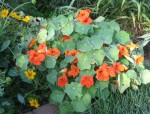 Annuals provide bright color beginning in spring and are important part a cottage garden. Typically, cottage garden annuals are easy to grow, vigorous, and self-seed, requiring little care and assistance. To get the cottage garden off to an early start, make a selection of cool weather plants with seeds that germinate before the soil has warmed. Combine them with a variety of bulbs and you can have have a beautiful cottage garden all spring long. For more on cottage garden bulbs see my post on Spring Blooming Bulbs for the Cottage Garden.
Annuals provide bright color beginning in spring and are important part a cottage garden. Typically, cottage garden annuals are easy to grow, vigorous, and self-seed, requiring little care and assistance. To get the cottage garden off to an early start, make a selection of cool weather plants with seeds that germinate before the soil has warmed. Combine them with a variety of bulbs and you can have have a beautiful cottage garden all spring long. For more on cottage garden bulbs see my post on Spring Blooming Bulbs for the Cottage Garden.
Here are five cool weather annuals that have traditionally been found in cottage gardens.
 Sweet Pea (Lathyrus odoratus)
Sweet Pea (Lathyrus odoratus)
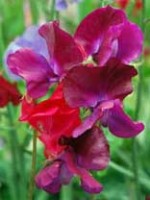 No flower is more romantic than the frilly, fragrant sweet pea. But modern varieties have lost the fragrance so check the seed pack if fragrance is important to you. The flower consist of a large rounded petal (the banner or standard) and two lower petals that are somewhat united forming a keel. The flowers are held in clusters on long stems making them excellent flowers for the vase. In the garden they are climbers and can be grown on a fence, trellis or teepee.
No flower is more romantic than the frilly, fragrant sweet pea. But modern varieties have lost the fragrance so check the seed pack if fragrance is important to you. The flower consist of a large rounded petal (the banner or standard) and two lower petals that are somewhat united forming a keel. The flowers are held in clusters on long stems making them excellent flowers for the vase. In the garden they are climbers and can be grown on a fence, trellis or teepee.
-
Light; Full sun
Soil: Fertile, deeply dug, moist, well drained
Size: Climbers to 5’; bush 12-36”
For additional information see my post on Growing Sweet Peas In Warm Climates.
 Nasturtium (Tropaeolum majus)
Nasturtium (Tropaeolum majus)
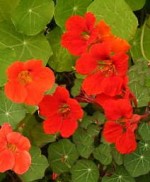 The long slender spurs of the flowers plus the round leaves with their central attachment to the petiole make the nasturtium an endearing plant in any garden. Although nasturtiums were originally climbers, they now can be grown as compact bedding plants. The flowers are mostly red and orange but yellow and cream varieties are available. The young leaves and flowers have a peppery taste can be used in salads or as a tasty garnish, while their pods and seed are pickled as a substitute for capers.
The long slender spurs of the flowers plus the round leaves with their central attachment to the petiole make the nasturtium an endearing plant in any garden. Although nasturtiums were originally climbers, they now can be grown as compact bedding plants. The flowers are mostly red and orange but yellow and cream varieties are available. The young leaves and flowers have a peppery taste can be used in salads or as a tasty garnish, while their pods and seed are pickled as a substitute for capers.
-
Light: Full sun
Soil: Average, well drained (fertile soil will produce lush foliage and few flowers)
Size: Dwarfs: 15”; climbers 6-10’
 Stock (Matthiola incana)
Stock (Matthiola incana)
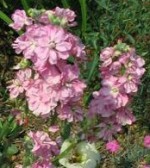 The spicy fragrance of stock flowers is only one of the reasons to grow this wonderful plant. The ruffled single or double flowers are thickly clustered on stout stems and come in a huge variety of colors including white, cream, apricot, lavender, purple, pink, red and bicolors. They make beautiful additions to bouquets. No wonder the English have been growing stock in their garden since the early 16th century.
The spicy fragrance of stock flowers is only one of the reasons to grow this wonderful plant. The ruffled single or double flowers are thickly clustered on stout stems and come in a huge variety of colors including white, cream, apricot, lavender, purple, pink, red and bicolors. They make beautiful additions to bouquets. No wonder the English have been growing stock in their garden since the early 16th century.
-
Light: Full sun
Soil: Moderately rich, moist, well drained.
Size: 12-30”
 Snapdragon (Anthirrhium majus)
Snapdragon (Anthirrhium majus)
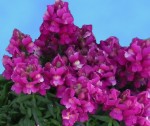 Snapdragon (Antirrhinum majus)The famous English garden designer Gertrude Jekyll loved snapdragons but so do cottage gardeners. The exquisite flowers reflect their name as can be seen by pinching the throat of the flower and watching the hinged blossom open and close. The flowers are borne in spikes opening from top to bottom and come in reddish purple, lavender, crimson, red, white, yellow, bronze, orange, pink, and combinations. Unfortunately the plants are prone to rust, a fungus disease that can do them in; cut them for the vase when half the flowers are open and this will encourage additional stems and delay the development of rust.
Snapdragon (Antirrhinum majus)The famous English garden designer Gertrude Jekyll loved snapdragons but so do cottage gardeners. The exquisite flowers reflect their name as can be seen by pinching the throat of the flower and watching the hinged blossom open and close. The flowers are borne in spikes opening from top to bottom and come in reddish purple, lavender, crimson, red, white, yellow, bronze, orange, pink, and combinations. Unfortunately the plants are prone to rust, a fungus disease that can do them in; cut them for the vase when half the flowers are open and this will encourage additional stems and delay the development of rust.
-
Light: Full sun
Soil: Moderately rich soil, moist, well drained.
Size: 12-36”
 Bachelor’s button/Cornflower (Centaurea cynus)
Bachelor’s button/Cornflower (Centaurea cynus)
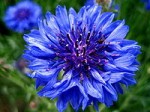 The dense, thistle like flower heads of Bachelor’s button are borne with attractive grayish foliage on tall slender plants giving a lacy look to the border. Flowers come in blue, pink, or white and are very useful in both fresh and dried arrangements. The common name bachelor’s button comes from the fact that it was the traditional boutonniere because it lasted so long out of water.
The dense, thistle like flower heads of Bachelor’s button are borne with attractive grayish foliage on tall slender plants giving a lacy look to the border. Flowers come in blue, pink, or white and are very useful in both fresh and dried arrangements. The common name bachelor’s button comes from the fact that it was the traditional boutonniere because it lasted so long out of water.
-
Light: Full sun
Soil: Average, well drained
Size: 1-2’
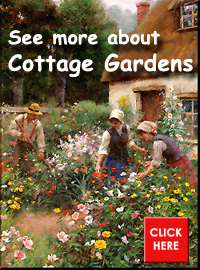 If you are lucky enough to live in England, or the Pacific Northwest you may be able to enjoy these flowers into summer but for those of us that live in the South they will be short lived. Once the temperatures are in the 80’s they will decline but meanwhile the perennials and warm weather annuals will be coming along to take their place.
If you are lucky enough to live in England, or the Pacific Northwest you may be able to enjoy these flowers into summer but for those of us that live in the South they will be short lived. Once the temperatures are in the 80’s they will decline but meanwhile the perennials and warm weather annuals will be coming along to take their place.